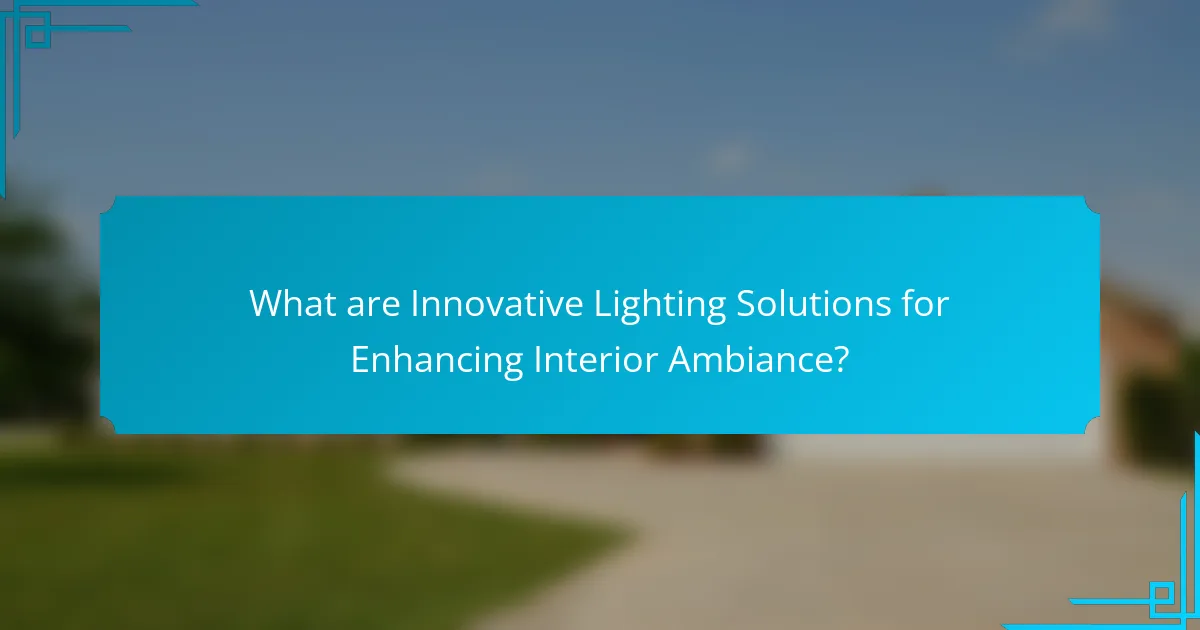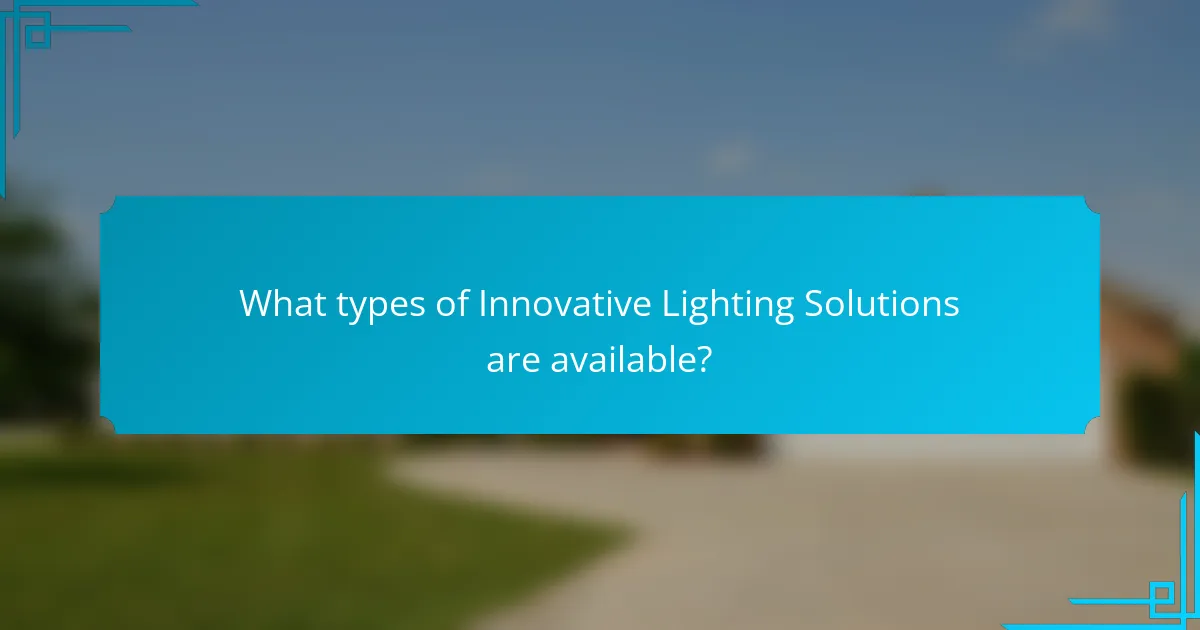Innovative lighting solutions significantly enhance interior ambiance through various technologies and designs. Key solutions include smart lighting systems, which allow remote control of brightness and color temperature, and energy-efficient LED technology that reduces maintenance costs. Layered lighting designs combine ambient, task, and accent lighting to create depth and functionality in spaces. Additional options like OLED lighting, solar-powered solutions, and tunable white lighting further improve aesthetic appeal and well-being by mimicking natural light patterns. These advancements not only enhance the atmosphere of interior spaces but also promote energy efficiency and convenience.

What are Innovative Lighting Solutions for Enhancing Interior Ambiance?
Innovative lighting solutions for enhancing interior ambiance include smart lighting, LED technology, and layered lighting designs. Smart lighting systems allow users to control brightness and color temperature remotely. This flexibility can create different moods for various occasions. LED technology offers energy efficiency and long lifespan, reducing maintenance costs. Layered lighting combines ambient, task, and accent lighting to create depth in a space. For instance, pendant lights over dining areas provide functional illumination while enhancing aesthetics. Color-changing LED strips can add vibrancy and personalization to rooms. These solutions not only improve functionality but also significantly enhance the overall atmosphere of interior spaces.
How do these lighting solutions differ from traditional options?
Innovative lighting solutions differ from traditional options primarily in their energy efficiency and adaptability. These modern solutions often utilize LED technology, which consumes significantly less energy than incandescent or fluorescent bulbs. For instance, LEDs can use up to 75% less energy than traditional lighting. Additionally, innovative options offer features like smart controls, allowing users to adjust brightness and color temperature remotely. This flexibility enhances user experience and ambiance customization. Furthermore, many innovative lighting solutions have longer lifespans, with some LEDs lasting up to 25,000 hours compared to 1,000 hours for traditional bulbs. This combination of efficiency, adaptability, and longevity sets innovative lighting solutions apart from their traditional counterparts.
What technologies are utilized in innovative lighting solutions?
Innovative lighting solutions utilize several key technologies. These include LED technology, which offers energy efficiency and longevity. Smart lighting systems enable remote control and automation. Dimming technology allows for adjustable brightness levels. Color temperature control enhances mood by adjusting light warmth. Wireless communication technologies facilitate integration with smart home systems. Sensors, such as motion and daylight sensors, optimize energy usage. These technologies collectively contribute to enhanced interior ambiance and user experience.
How do these technologies enhance the ambiance of a space?
Innovative lighting technologies enhance the ambiance of a space by creating tailored environments. These technologies adjust brightness and color temperature to suit different activities. For example, warm lighting fosters relaxation, while bright lighting supports focus. Smart lighting systems can be programmed to change throughout the day, mimicking natural light patterns. This adaptability helps to improve mood and productivity. Additionally, the use of dynamic lighting can highlight architectural features, adding visual interest. Studies show that well-designed lighting can positively affect human emotions and behaviors. A study by the Lighting Research Center found that appropriate lighting can reduce stress and increase comfort levels.
Why is interior ambiance important for spaces?
Interior ambiance is important for spaces because it influences mood and behavior. A well-designed ambiance can enhance comfort and well-being. Studies show that lighting affects emotional responses. For example, natural light can improve productivity and reduce stress. Conversely, harsh lighting can lead to discomfort and fatigue. Additionally, ambiance contributes to the aesthetic appeal of a space. It can create a welcoming atmosphere for guests or customers. Overall, the right ambiance can significantly impact the experience within a space.
How does lighting influence mood and behavior?
Lighting significantly influences mood and behavior. Bright lighting can enhance alertness and energy levels. Conversely, dim lighting promotes relaxation and calmness. Studies show that exposure to natural light improves mood and productivity. A 2014 study published in the Journal of Environmental Psychology found that bright environments lead to increased creativity. Moreover, color temperature affects emotional responses; warmer tones evoke comfort, while cooler tones can stimulate focus. Thus, the type and intensity of lighting play crucial roles in shaping our emotional and behavioral responses.
What role does lighting play in interior design?
Lighting is crucial in interior design as it influences the atmosphere and functionality of a space. It enhances visual appeal and sets the mood. Proper lighting can highlight architectural features and artwork. It also affects color perception and spatial perception. Different types of lighting, such as ambient, task, and accent, serve specific purposes. For example, ambient lighting provides overall illumination, while task lighting focuses on specific areas for activities. Studies show that well-designed lighting can improve mood and productivity. Therefore, effective lighting design is essential for creating inviting and functional interiors.

What types of Innovative Lighting Solutions are available?
Smart LED lighting systems are a prominent type of innovative lighting solution. These systems allow users to control brightness and color through mobile apps. They can also integrate with home automation systems for enhanced convenience. Another type is OLED (Organic Light Emitting Diode) lighting, known for its thin, flexible design. OLEDs provide even illumination and can be incorporated into various surfaces. Additionally, there are solar-powered lighting solutions, which utilize renewable energy. These lights are efficient and environmentally friendly. Finally, there are tunable white lighting systems that adjust color temperature throughout the day. This mimics natural light patterns and enhances well-being. Each of these solutions contributes to improving interior ambiance effectively.
What are the most popular forms of innovative lighting?
The most popular forms of innovative lighting include LED fixtures, smart lighting systems, and OLED panels. LED fixtures are energy-efficient and long-lasting, making them a preferred choice for modern spaces. Smart lighting systems allow users to control brightness and color remotely, enhancing convenience and personalization. OLED panels provide a sleek, thin design that offers uniform light distribution. These forms of lighting are increasingly used in residential and commercial settings due to their versatility and energy efficiency.
How do smart lighting systems work?
Smart lighting systems operate by using connected technology to control lighting remotely. These systems typically integrate with Wi-Fi or Bluetooth networks. Users can manage lights through mobile apps or voice assistants. Smart bulbs contain sensors and microchips that allow for customization. They can adjust brightness and color temperature based on user preferences. Many systems also include scheduling features for automated lighting. Data from user interactions helps optimize energy usage. Research shows that smart lighting can improve energy efficiency by up to 30%.
What are the benefits of using LED lighting?
LED lighting offers numerous benefits. It is energy-efficient, consuming up to 80% less energy than traditional incandescent bulbs. This efficiency leads to lower electricity bills and reduced carbon footprints. LED lights have a longer lifespan, lasting up to 25,000 hours compared to 1,000 hours for incandescent bulbs. This longevity reduces the frequency of replacements, saving both time and resources. Additionally, LED lighting produces less heat, enhancing safety and comfort in indoor environments. They are available in various colors and intensities, allowing for versatile design options. Furthermore, LED lights are environmentally friendly as they do not contain toxic materials like mercury. These attributes make LED lighting a superior choice for modern interior ambiance.
How can innovative lighting solutions be integrated into different environments?
Innovative lighting solutions can be integrated into different environments by utilizing adaptive technologies and design strategies. These solutions include smart lighting systems that adjust brightness and color based on the time of day or occupancy. For example, in residential settings, dimmable LED fixtures can create cozy atmospheres for relaxation. In commercial spaces, dynamic lighting can enhance productivity by mimicking natural light patterns. Additionally, integrating lighting with smart home devices allows for remote control and automation. Studies show that proper lighting can improve mood and well-being, making it essential for various environments. In hospitality, customizable lighting enhances guest experiences, while in retail, strategic lighting highlights products and influences purchasing decisions. Overall, the integration of innovative lighting solutions is vital for optimizing functionality and aesthetics across different settings.
What are the best practices for residential spaces?
Best practices for residential spaces include optimizing natural light, using layered lighting, and selecting appropriate fixtures. Natural light enhances mood and reduces energy costs. Layered lighting combines ambient, task, and accent lighting for versatility. Choosing fixtures that complement the space improves aesthetics and functionality. Additionally, utilizing dimmers allows for adjustable lighting, catering to different activities and times of day. Incorporating energy-efficient bulbs supports sustainability and lowers electricity bills. Regular maintenance of lighting fixtures ensures safety and longevity.
How can commercial spaces benefit from innovative lighting solutions?
Commercial spaces can benefit from innovative lighting solutions by enhancing energy efficiency, improving aesthetics, and boosting employee productivity. Innovative lighting solutions, such as LED technology and smart lighting systems, consume less energy compared to traditional lighting. This reduction in energy use leads to lower utility costs, making operations more sustainable.
Moreover, innovative lighting can create a more inviting atmosphere. Adjustable color temperatures and brightness levels can be tailored to different areas, enhancing the overall ambiance. Research shows that well-designed lighting can increase customer satisfaction and dwell time in retail environments.
Additionally, studies indicate that proper lighting can improve employee performance. A well-lit workspace reduces eye strain and enhances focus, leading to increased productivity. According to a report from the American Society of Interior Designers, 68% of employees feel more productive in environments with good lighting.
In summary, commercial spaces benefit from innovative lighting solutions through energy savings, improved aesthetics, and enhanced employee productivity.

What are the practical applications of Innovative Lighting Solutions?
Innovative lighting solutions are used in various practical applications to enhance interior ambiance. These solutions include smart lighting systems that allow for remote control and automation. They can adjust brightness and color temperature according to the time of day or activity. Energy-efficient LED lighting provides significant cost savings and reduced environmental impact. Accent lighting highlights architectural features or artwork, creating focal points in a space. Mood lighting can transform the atmosphere for events or relaxation. Task lighting improves functionality in workspaces by providing focused illumination. Finally, dynamic lighting can change throughout the day to mimic natural light, promoting well-being.
How can innovative lighting enhance specific areas within a space?
Innovative lighting can enhance specific areas within a space by improving visibility and creating mood. For example, task lighting in a kitchen helps with food preparation. Accent lighting can highlight artwork or architectural features, drawing attention to them. Ambient lighting establishes a comfortable atmosphere for relaxation. Color-changing LED lights can adjust the mood based on the time of day or activity. These lighting solutions can also influence productivity; studies show well-lit spaces can enhance focus. Furthermore, innovative lighting can increase safety by illuminating walkways and staircases. Overall, the strategic use of lighting significantly impacts functionality and aesthetics within interior spaces.
What lighting solutions are best for creating focal points?
Accent lighting solutions are best for creating focal points. These solutions include track lighting, spotlights, and wall sconces. Track lighting allows for adjustable fixtures to highlight specific areas. Spotlights provide concentrated beams of light on artwork or architectural features. Wall sconces add depth and texture to walls while illuminating key areas. Additionally, pendant lights can serve as striking focal points over tables or islands. Using dimmers enhances flexibility in creating desired moods. Studies show that proper lighting can significantly impact how spaces are perceived.
How can lighting be used to define different zones in an interior?
Lighting can be used to define different zones in an interior by creating distinct atmospheres for each area. Task lighting can illuminate workspaces, enhancing functionality. Ambient lighting can provide overall illumination, making spaces feel larger and more inviting. Accent lighting can highlight artwork or architectural features, drawing attention to specific zones. Color temperature can influence the mood; warmer tones create a cozy feel, while cooler tones promote focus. Layering these lighting types helps to visually separate areas without physical barriers. Studies show that well-defined lighting zones improve spatial perception and enhance user experience in interiors.
What tips can be applied for selecting the right lighting solution?
Consider the purpose of the space when selecting a lighting solution. Different activities require different lighting types. For example, task lighting is essential for work areas. Ambient lighting creates a comfortable atmosphere in living spaces. Evaluate the size of the room to determine the appropriate brightness. Larger rooms may need multiple light sources to avoid shadows. Take into account the color temperature of the bulbs. Warmer tones create a cozy feel, while cooler tones enhance focus. Assess the energy efficiency of the lighting options. LED bulbs consume less energy and last longer than traditional bulbs. Finally, think about the style and design of the fixtures. They should complement the overall decor of the space.
How can one assess the needs of a space for optimal lighting?
To assess the needs of a space for optimal lighting, one should evaluate the purpose of the space. Different activities require varying light intensities and qualities. Next, consider the size and layout of the area. Larger spaces may need multiple light sources for even illumination. Assess natural light availability, as windows and skylights impact lighting needs. Identify key tasks performed in the space to determine specific lighting requirements. Finally, consider the color scheme and furnishings, as they affect light reflection and absorption. Conducting this thorough assessment ensures that lighting solutions meet both functional and aesthetic needs.
What common mistakes should be avoided when choosing lighting solutions?
Common mistakes to avoid when choosing lighting solutions include selecting the wrong brightness levels. Insufficient lighting can create a dim atmosphere, while excessive brightness can cause glare. Another mistake is ignoring the color temperature of bulbs. Warmer tones create a cozy feel, while cooler tones can appear harsh. Failing to consider the purpose of the space is also critical. Different areas require different types of lighting, such as task, ambient, or accent. Additionally, neglecting energy efficiency can lead to higher electricity bills. Choosing non-dimmable fixtures in spaces where flexibility is needed can limit ambiance control. Lastly, overlooking the importance of fixture placement can result in uneven lighting and shadows.
Innovative lighting solutions are advanced technologies designed to enhance interior ambiance through improved energy efficiency, adaptability, and aesthetic appeal. Key solutions include smart lighting systems, LED technology, and layered lighting designs that allow for customizable brightness and color temperature. The article explores the differences between these modern options and traditional lighting, the technologies involved, and their impact on mood and productivity. Additionally, it discusses practical applications and best practices for integrating these solutions in residential and commercial spaces, emphasizing their role in creating inviting environments and improving functionality.